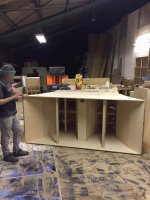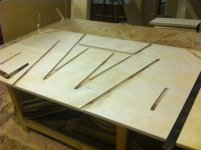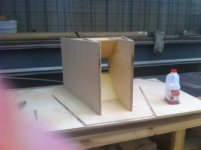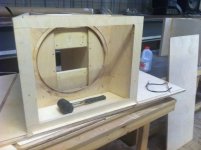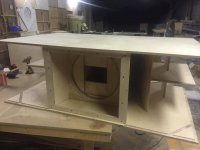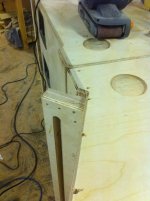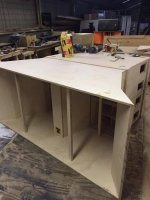Ro808 has contributed quite a lot to your thread for you to now be calling what he knows into question.
Pot calling the kettle black comes to mind on that...
I would assume the "cupped hand" comment to be referring to "horn honk". Neither phrase have much in the way of agreement as to their meanings but here is some nice experiments on the matter.
https://www.audioheritage.org/vbull...Waveguides&s=24fff84a60971775f9ce0751d483534b
Pot calling the kettle black comes to mind on that...
I would assume the "cupped hand" comment to be referring to "horn honk". Neither phrase have much in the way of agreement as to their meanings but here is some nice experiments on the matter.
https://www.audioheritage.org/vbull...Waveguides&s=24fff84a60971775f9ce0751d483534b
Indeed, those aren't true front loaded horns, as a result the low end extension is more or less fixed.It’s worth noting that a BPH, such as used by Funktion One, acoustically behaves much more like a reflex enclosure at low frequencies than it does a horn. There’s a paper by Bright, 2003 that explores this in detail using BEM.
The boost in on-axis output in that case is most likely attributed to the increase in mouth area & the resulting confinement of radiation to a smaller area - or put another way, the shift down in frequency of the transition to omnidirectional behaviour. Charlie Hughes has a good paper on this on his Excelsior website.
The 'Hornvorsatz' (I like some German words 😉) for the F218 Infrabass doesn't extent the low end either, it only boosts the output by 10 dB.
This however...
Last edited:
Is there any validity in this guy's remarks because he just sounds like a person who doesn't know what he's talking about...
"cupped hand sound"??? Lets see the FR of this type of speaker.... he doesnt seem to know the difference....
AKA throat distortion down in the ~450-900 Hz octave and no doubt (in my mind) why W.E./Lansing/Altec added conical WG driver adapters to most, if not all, of their 500, 800 Hz horns designed for speech, so apparently he's referring to prosound/PA trumpets that forgo this type adapter to emphasize this dip in our hearing response in high ambient noise. 'Dead giveaway' is when there's a ~straight pipe adapter.
you always listen in the sweet spot, The point is how large it is.
Rob 🙂
Sounds in real life... thats a bad example... tonal shifts, happen naturally... in real life lol...Hello Camplo
Because of this in actual use if you stand or move off axis there is a clearly audible tonal shift. It's essentially "head in vise". Speakers that do that do not sound real/natural to me using sounds in real life as an example. I will admit it's a preference but when at a real live event have you experienced a similar tonal balance change in a couple of feet?? I certainly haven't.
Rob 🙂
It ends up being purely preference....I've been listening to my horn at a 90 degree angle and its still amazing.............
You seem to be mistaken, I haven't questioned something ro808 knows lol... maybe quote what you are speaking on so that your point can be clear.Ro808 has contributed quite a lot to your thread for you to now be calling what he knows into question.
Is there any validity in this guy's remarks because he just sounds like a person who doesn't know what he's talking about...
"cupped hand sound"??? Lets see the FR of this type of speaker.... he doesnt seem to know the difference....
This guy is a hifi reviewer, so you're probably right about his (limited) knowledge of horn tech.
'Cupped hand sound' is often (unduly) associated with acoustic horns, but it does exist. Last time I experienced a similar effect - though I prefer 'band in a tunnel' type of sound, was in a club with 4 Danley SH50s.
Don't worry Kevmoso, Camplo and I are used to (friendly) provocation.
Last edited:
I would assume the "cupped hand" comment to be referring to "horn honk". Neither phrase have much in the way of agreement as to their meanings but here is some nice experiments on the matter.
https://www.audioheritage.org/vbull...Waveguides&s=24fff84a60971775f9ce0751d483534b
Frequency response... and hints at group delay...off axis is not a factor in "horn honk" it seems.
I think what excites me is a person who suggest that all horns/waveguides have "horn honk"....
"The Meyer Sound speakers are the only horn speakers that I’ve ever heard that I thought avoided that cupped hands sound that you get from most typical horn-loaded speakers"
"Some Horn-Honk is present in all horns and waveguides"
I am not sure about these guys... one says meyer has no horn honk... the other says they all have horn honk (to some degree)....
amplitude modulation with resonate peaks and exaggerated GD, near cutoff, sounds better.... either way, as long as the horn/waveguide is built properly is this even an issue??? Can this be fixed in the xo when the horn/waveguide performs well enough on its own???
I have this "horn honk".... something like +\-3db through that area, around 150hz...With filtering it should improve
Is it really that significant?
Last edited:
Tractrix horns, provided they are well made and not deployed outside their optimum operating range, should be devoid of 'honk'.
Well, it's common due to using too few, or the wrong, horns for the app, so driven to distortion same as a simple vent pipe 'huffs', 'chokes' at too high a pressure for its area, so basically any compression horn while the WG or less truncated (tractrix) impedance matches better to the surrounding air.I think what excites me is a person who suggest that all horns/waveguides have "horn honk"....
as long as the horn/waveguide is built properly is this even an issue??? Can this be fixed in the xo when the horn/waveguide performs well enough on its own???
I have this "horn honk".... something like +\-3db through that area, around 150hz...With filtering it should improve
Is it really that significant?
Small venue apps are the worst IME. 🙁 There's been many businesses over the decades I can't eat/whatever when they have live electrified entertainment and depending on the speakers, too often it's a 'one n' done'.
What horn is in the 150 Hz BW? This low our hearing acuity is rolling off, so surprised you'd notice it unless in a large, truncated wide range compression bass horn and not even then except at ear bleed levels.
Sorry for the interruption, but what is ”this” and where might any information be found?Indeed, those aren't true front loaded horns, as a result the low end extension is more or less fixed.
The 'Hornvorsatz' (I like some German words 😉) for the F218 Infrabass doesn't extent the low end either, it only boosts the output by 10 dB.
This however...
View attachment 1079508
Ive been looking at recreating a lascala/belle bottom to be used as a midbass module (50-150/200) for more slam impact between the subs and mains…….and ‘this’ looks to fit the bill perfectly.
"This" looks looks like a Sentry style bass horn with an extension.
Regards
Charles
Regards
Charles
Sounds in real life... thats a bad example... tonal shifts, happen naturally... in real life lol...
It ends up being purely preference....I've been listening to my horn at a 90 degree angle and its still amazing.............
WRT Tonal shifts: Of course they do but not so abruptly over short distances.
Again the point is how large the sweet spot is and beaming. It's not just preference it is measurable just look at the polar plots. Having a larger sweet spot has advantages. You chose a horn that is going to beam so obviously that's your preference.
That horn at a 90 angle sounds good to you?? Guess you like ceiling reflections?? Sounds like "user error" doing an evaluation not in the sweet spot.
Rob 🙂
Tractrix horns, provided they are well made and not deployed outside their optimum operating range, should be devoid of 'honk'.
Yes have you ever heard one of Bruce Edgars Titan systems?? Got to hear his set-up with his Seismic sub! They were stunning and effortless. No honk at all,
Rob
My elliptical tractrix horn cutoff is near that...above cutoff there is the amplitude modulation I described; a peak at ~170hz and ~290hz.... with about +\- 3 to 4db through the median....What horn is in the 150 Hz BW? This low our hearing acuity is rolling off, so surprised you'd notice it unless in a large, truncated wide range compression bass horn and not even then except at ear bleed levels.
looking at the measurement after voicing...(sorry no pic, broke my laptop keyboard)... my xo filter set at 200hz 48db... the 170hz peak is nulled by the HP....
This low our hearing acuity is rolling off, so surprised you'd notice it unless in a large, truncated wide range compression bass horn and not even then except at ear bleed levels.
This horn is truncated. These issues (for my horn) also happen within the room mode, likely lessening the blow. I feel that as long as I focus on getting a decent FR I'll never think about "horn honk"....I can hear it when played as a raw response but it wasn't exactly detrimental to listening. From the get go I've been
An excuse I used to make everything big....KISSThis low our hearing acuity is rolling off
Getting into perception....Are not those peaks leaning towards the high Q side? Are not lower Q filters much more potent in affecting perception of tone? Still an error is an error. It still seems to come down to the end result of FR.....If theres no such character in the resulting FR then Horn Honk is a feature, no longer.
I don't have any Long horn systems to compare, sadly....But this design above still has a +/- error the size of my natural horn honk...Whos counting?
Seems @GM has the most insight on the topic....He purposely pointed to a part of the spectrum that one might perceive as;
So this horn honk haunting might also be a factor of Where in the FR "trouble" occurs....."cupped hand" comment to be referring to "horn honk"
These cheat sheets are to be taken as the standard but we see the same range described as "Boxy" and coincidentally "Honkey"AKA throat distortion down in the ~450-900 Hz octave and no doubt (in my mind) why W.E./Lansing/Altec added conical WG driver adapters to most, if not all, of their 500, 800 Hz horns designed for speech
The time domain distortion part of it....Me...Mr. king of GD....I am having a hard timing discerning if I am hearing anything that I thought I would here....probably because of how low the GD peak is for my horn? I think potentially the notes may "Feel" different as a result? In the complexity of music, "level ground" or "up from down" would be lost fairly quickly. So its not an issue I can say that I have figured out, in particular without an identical source with the GD removed. I feel that the Large CSA of the Radiation Mass, increases direct energy to my ears, and in the balance of voicing, has less reverb of the room, helping to tame any sense of ringing... I definitely do not experience a sense of delayed arrival....but as I learned....the start up transient....starts on time. Really only an issue of transient part of the signal.
lol are you playing fair here? lol!!!That horn at a 90 angle sounds good to you?? Guess you like ceiling reflections?? Sounds like "user error" doing an evaluation not in the sweet spot.
First, a quote from another forum:Sorry for the interruption, but what is ”this” and where might any information be found?
Ive been looking at recreating a lascala/belle bottom to be used as a midbass module (50-150/200) for more slam impact between the subs and mains…….and ‘this’ looks to fit the bill perfectly.
"Upper plot is for the BH882 incl. Levan extension.
Bottom plot without the extension.
Plots show max. SPL by reaching Xmax of each driver.
red - Void V18-1000 (10.5mm)
blue - B&C 18TBX100 (9.5mm)
black - RCF L18/851K (9.0mm)
Input voltage for one driver @ 8ohm!"
Last edited:
And a beautifully executed copy, for the Oberton 18XB1500.
Attachments
Thanks Ro, after looking at the sentry iv mentioned earlier i stumbled onto the bertha and thought that was it…..A bit much for my living room! 😎
- Home
- Loudspeakers
- Multi-Way
- Is it possible to cover the whole spectrum, high SPL, low distortion with a 2-way?
